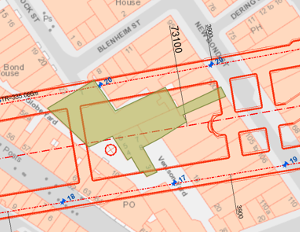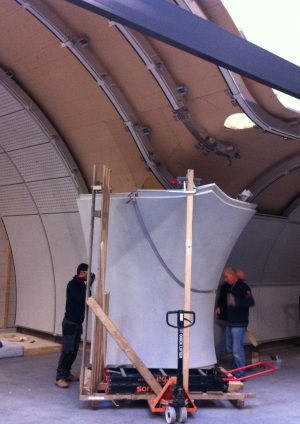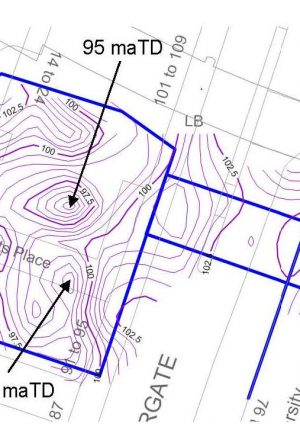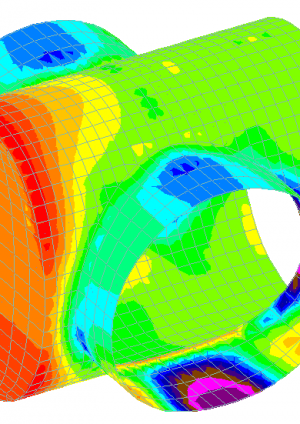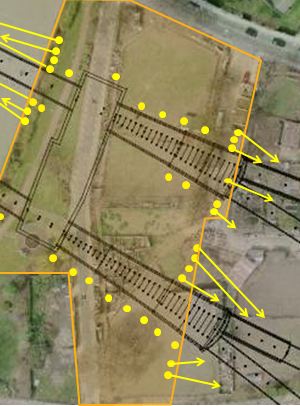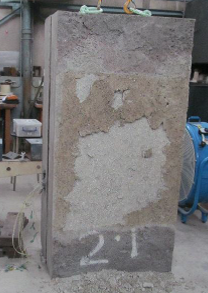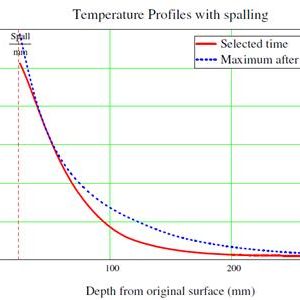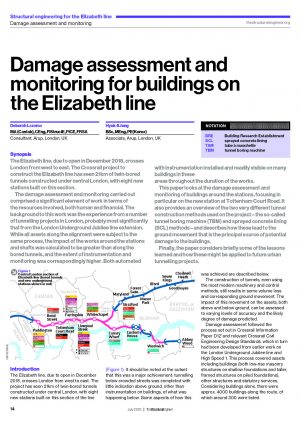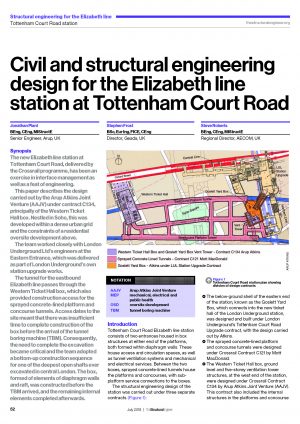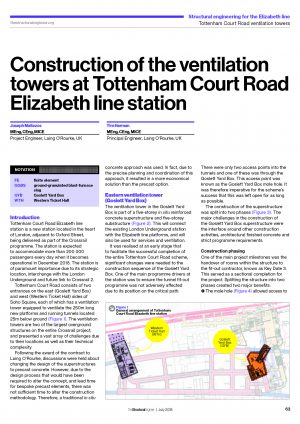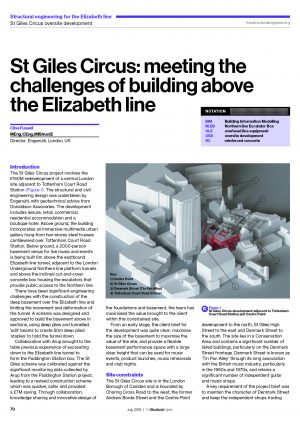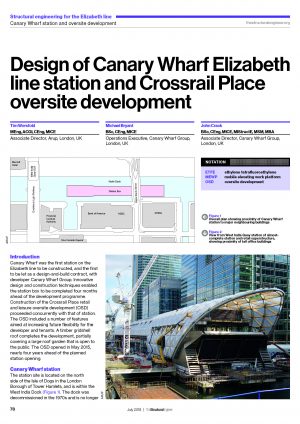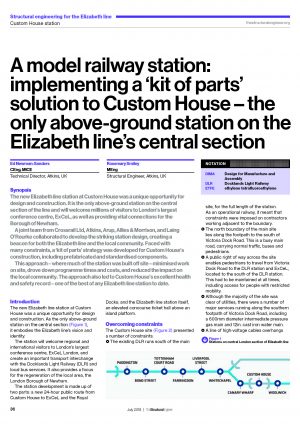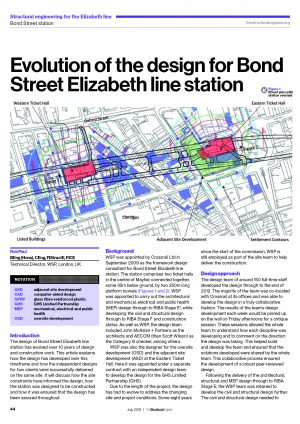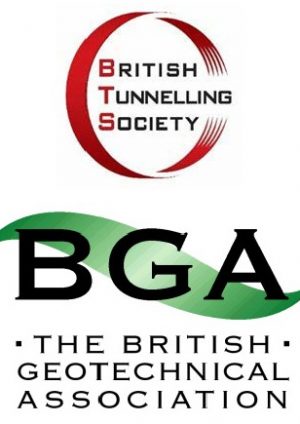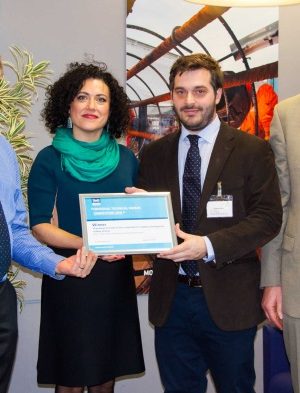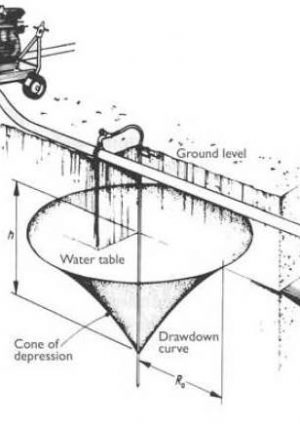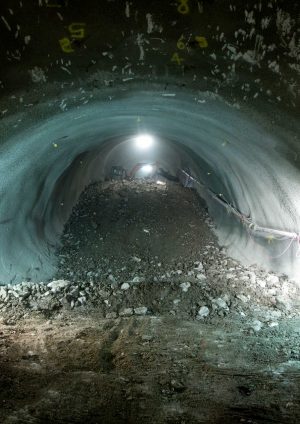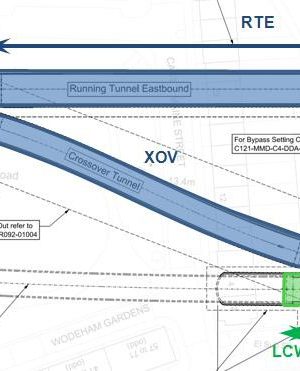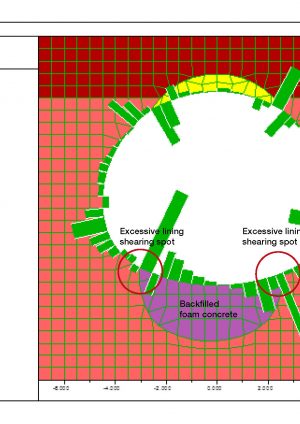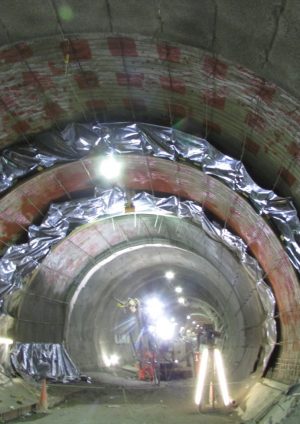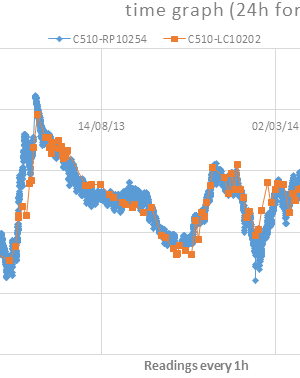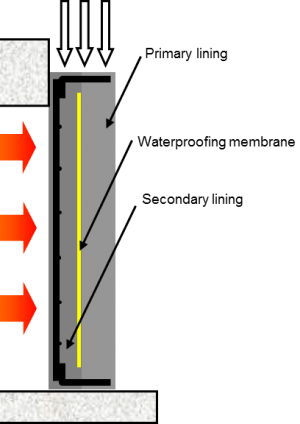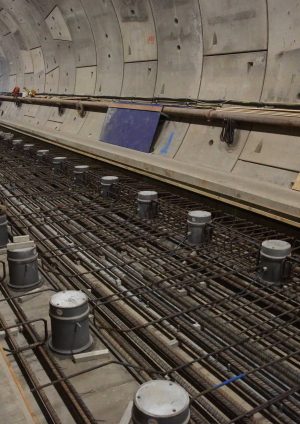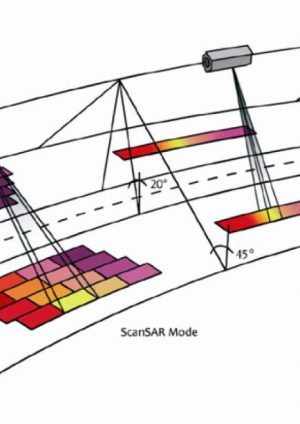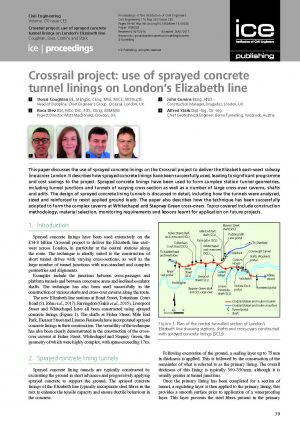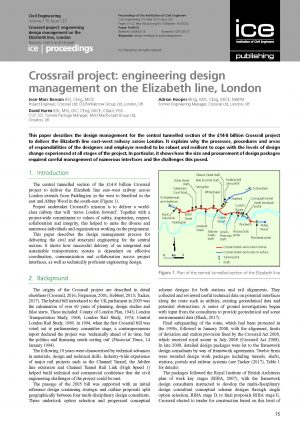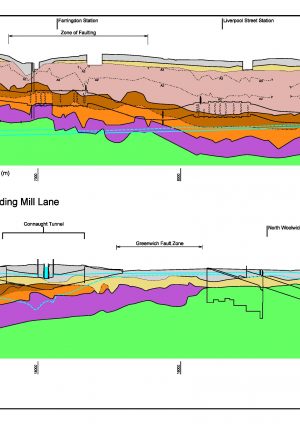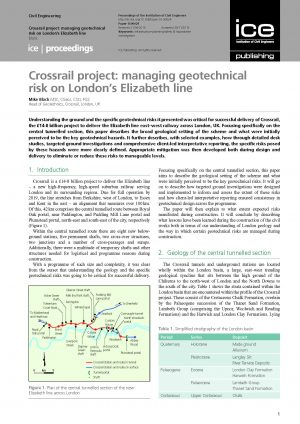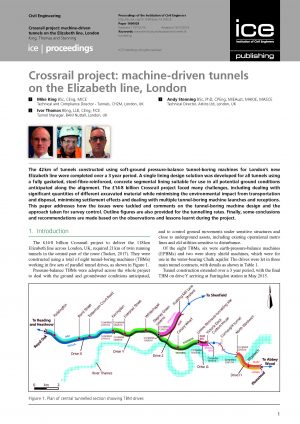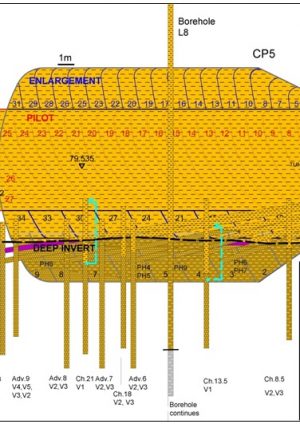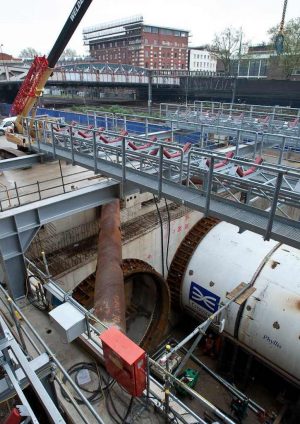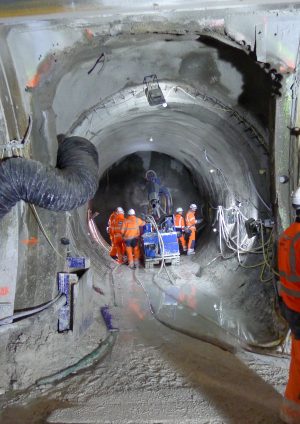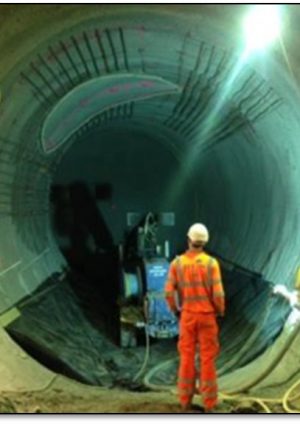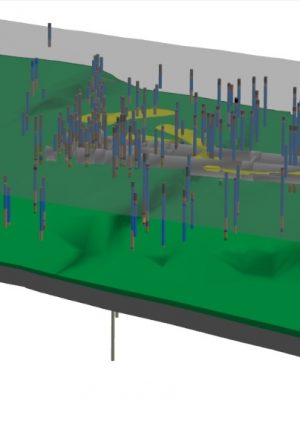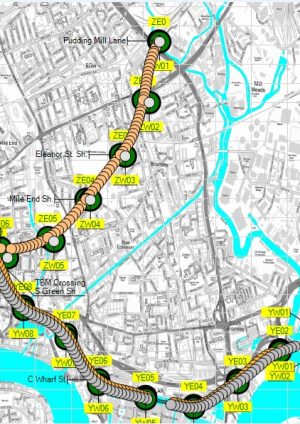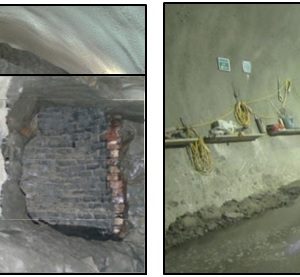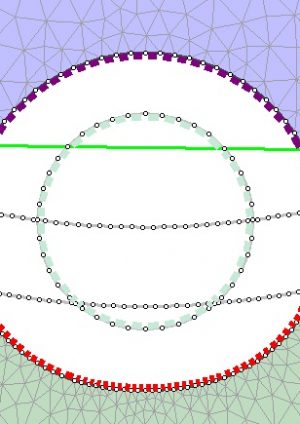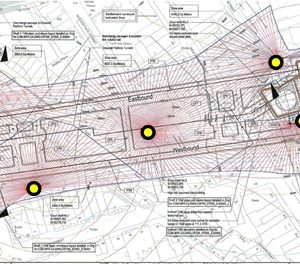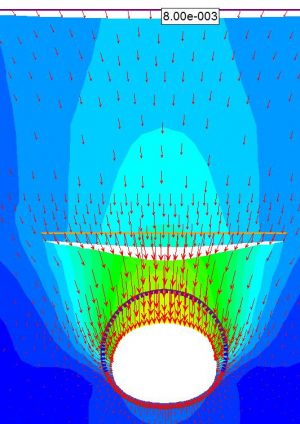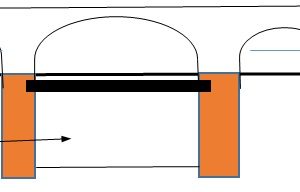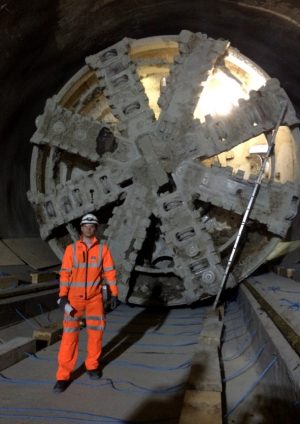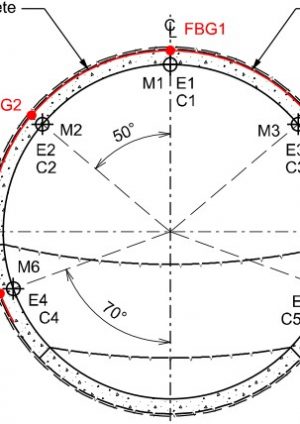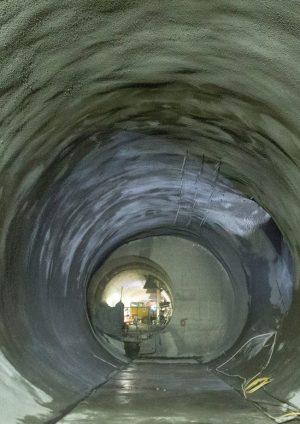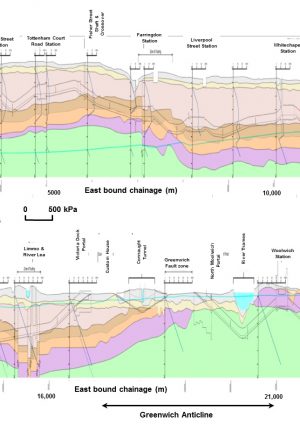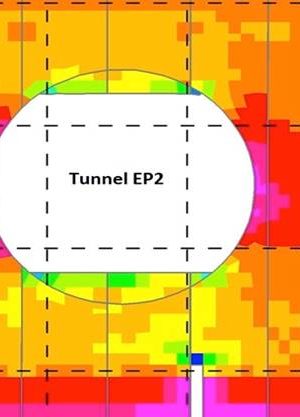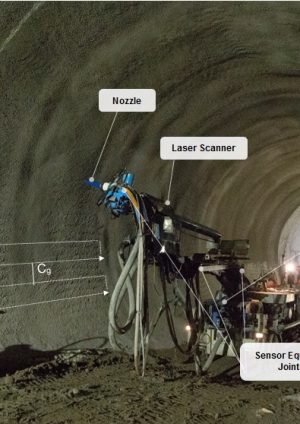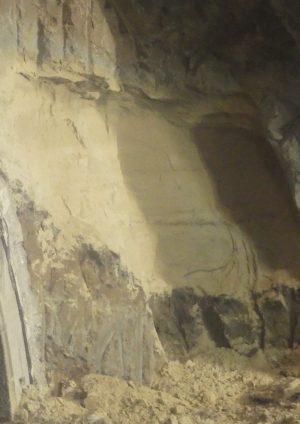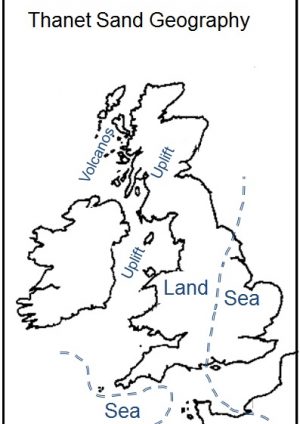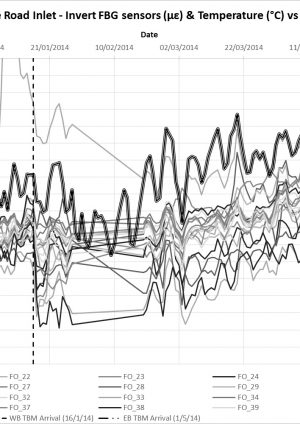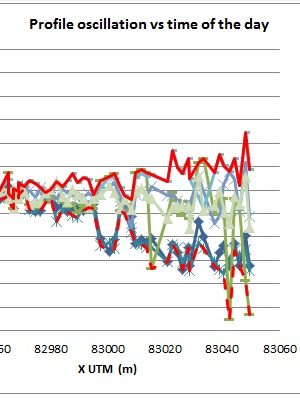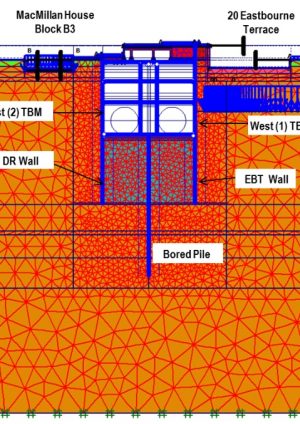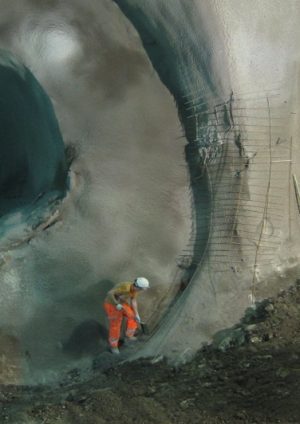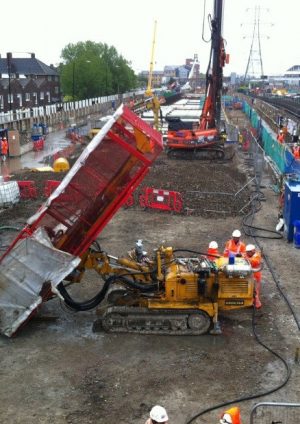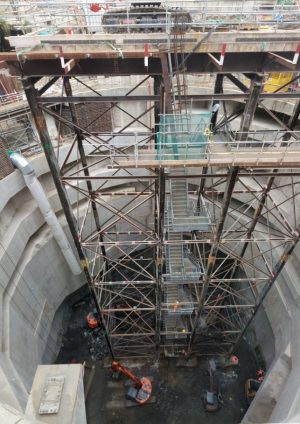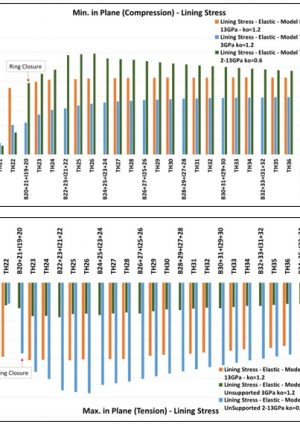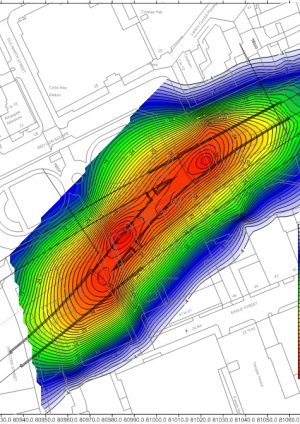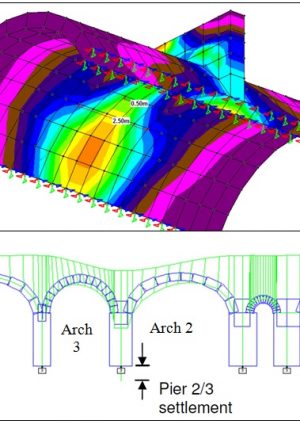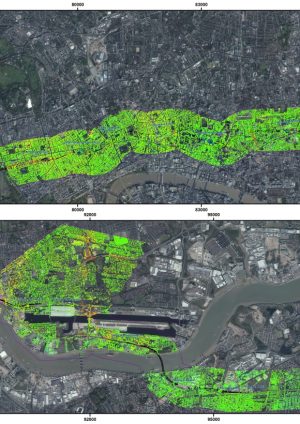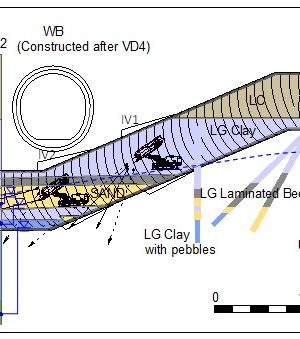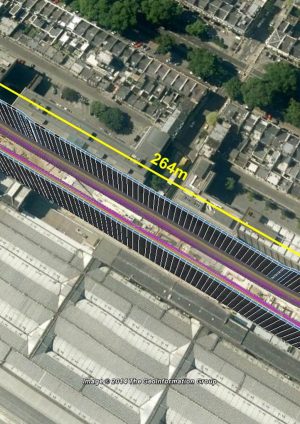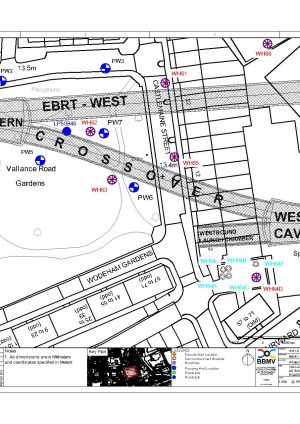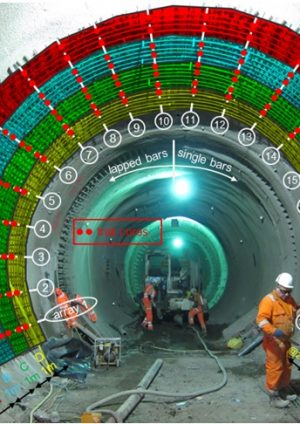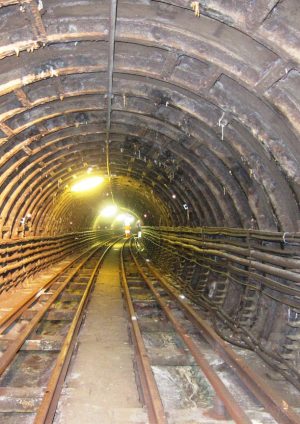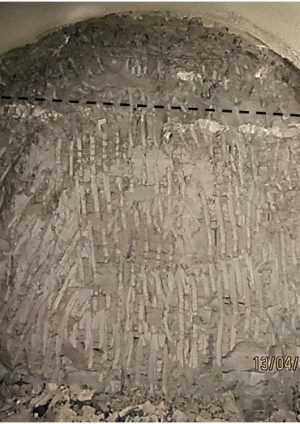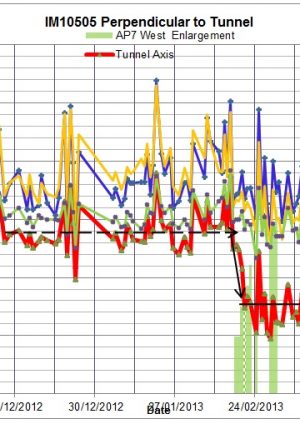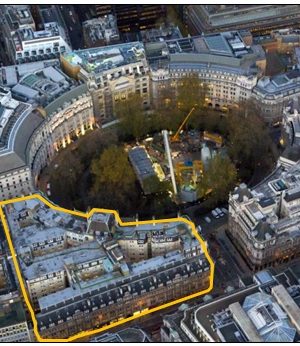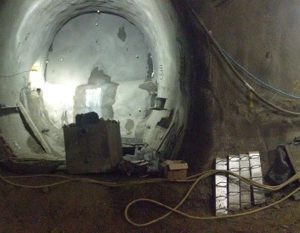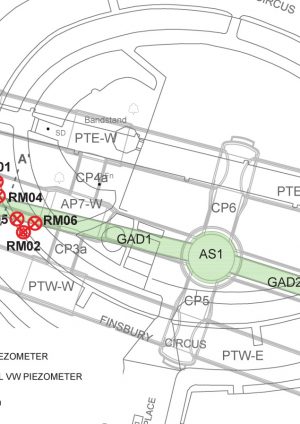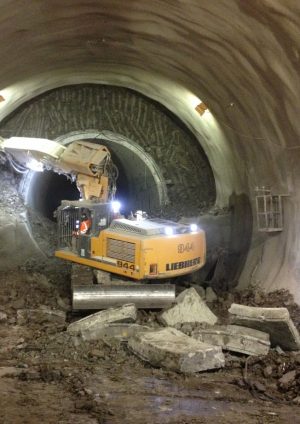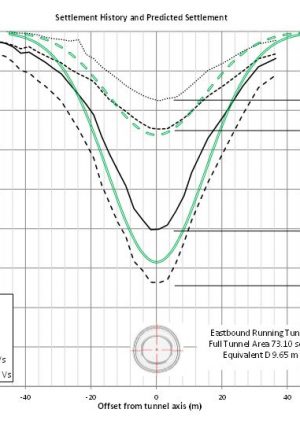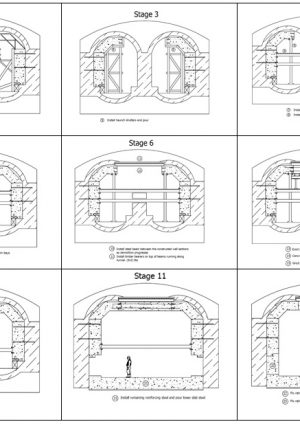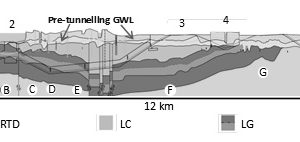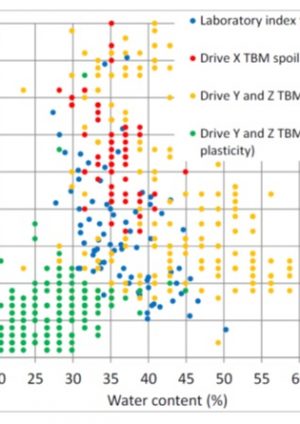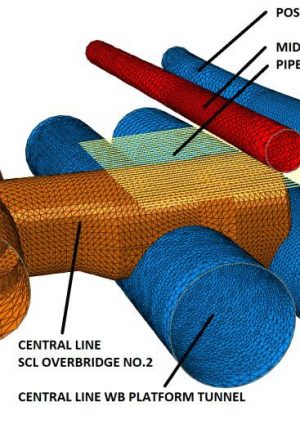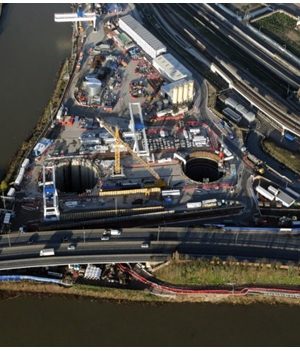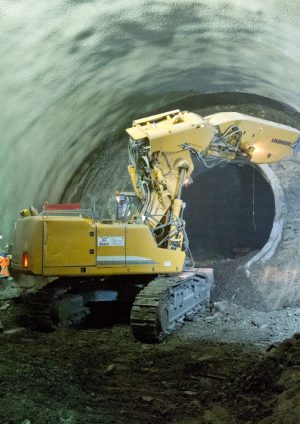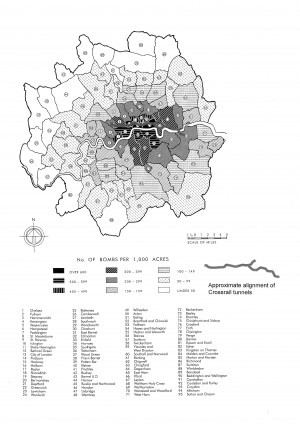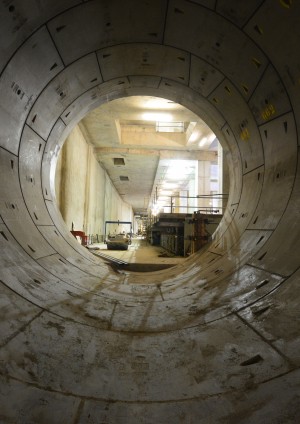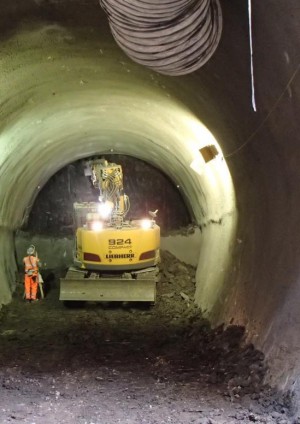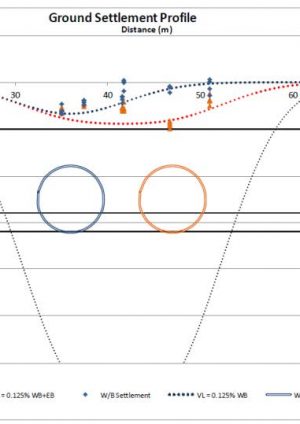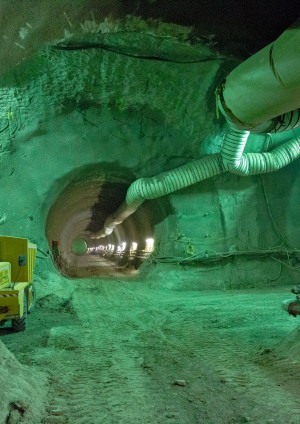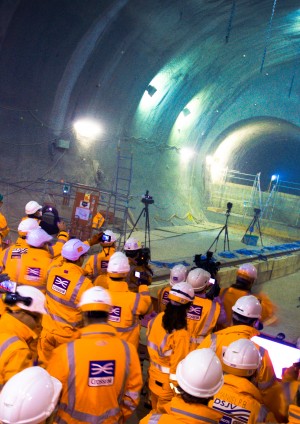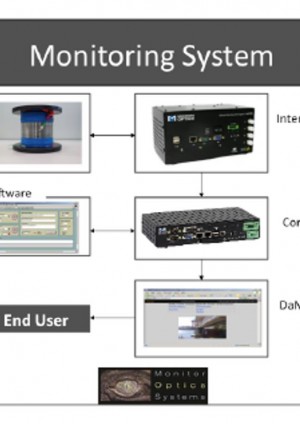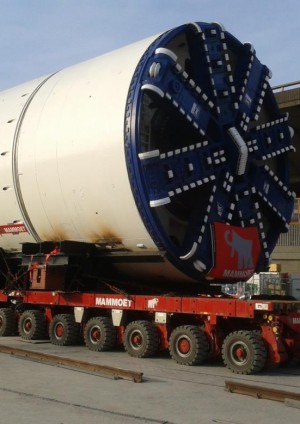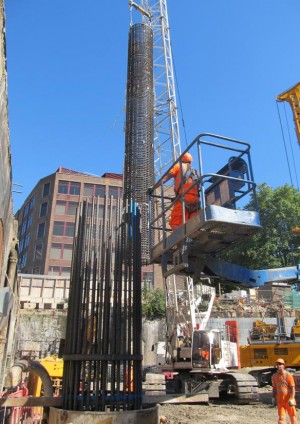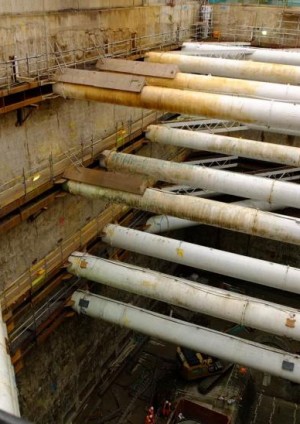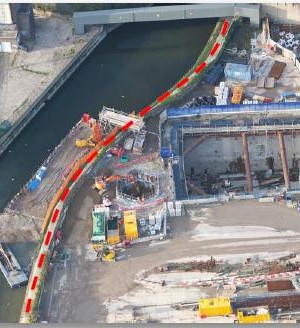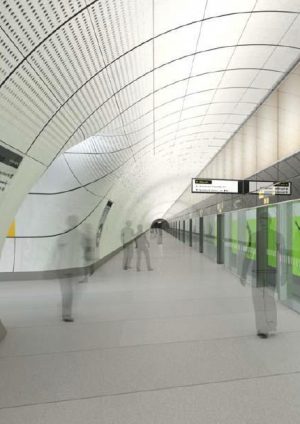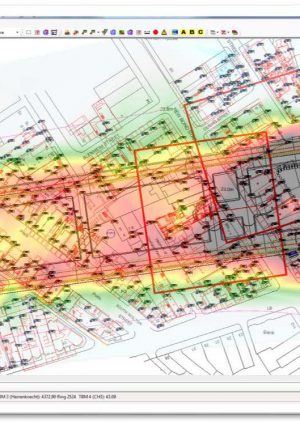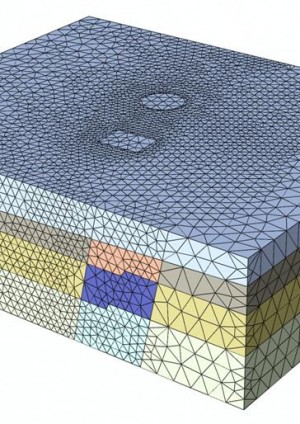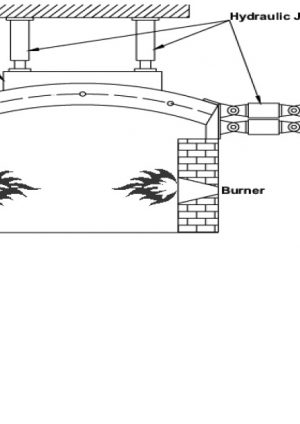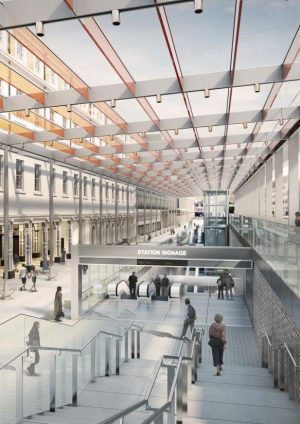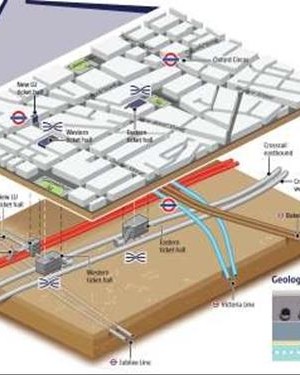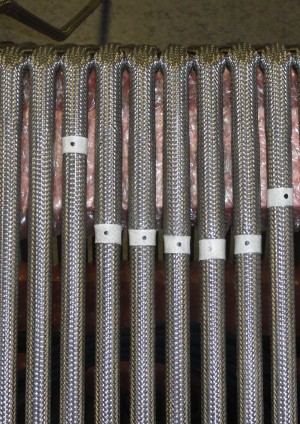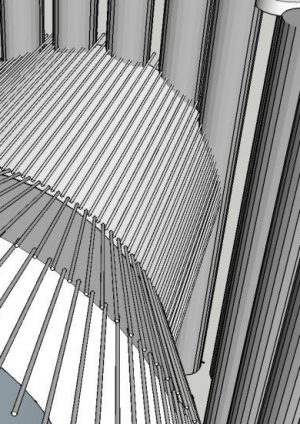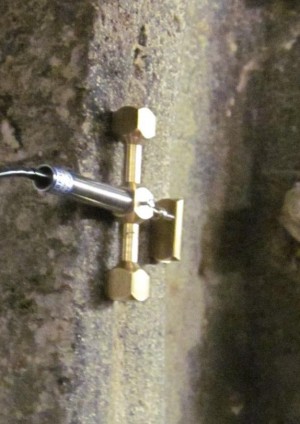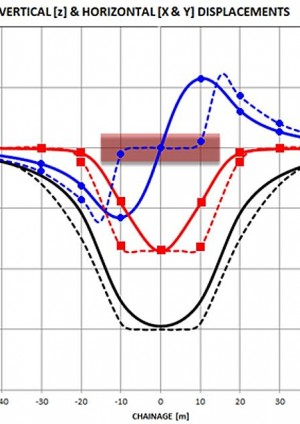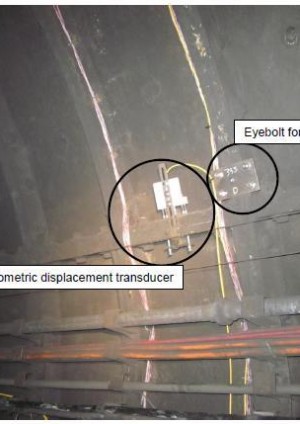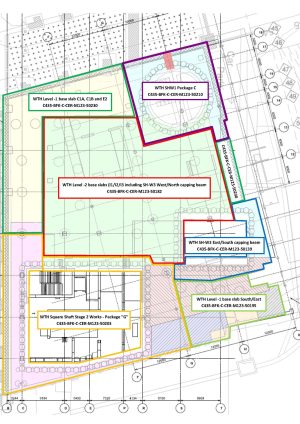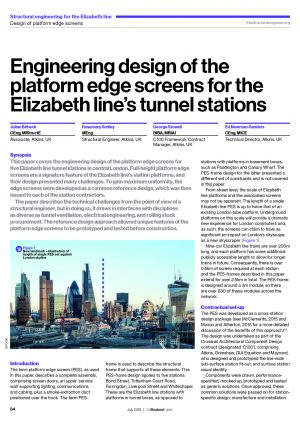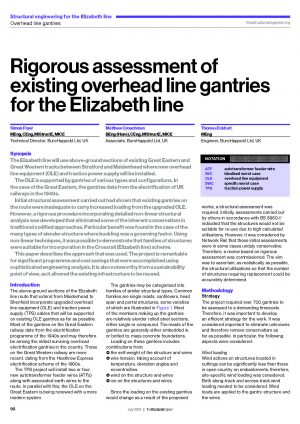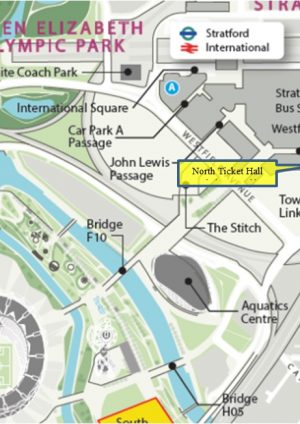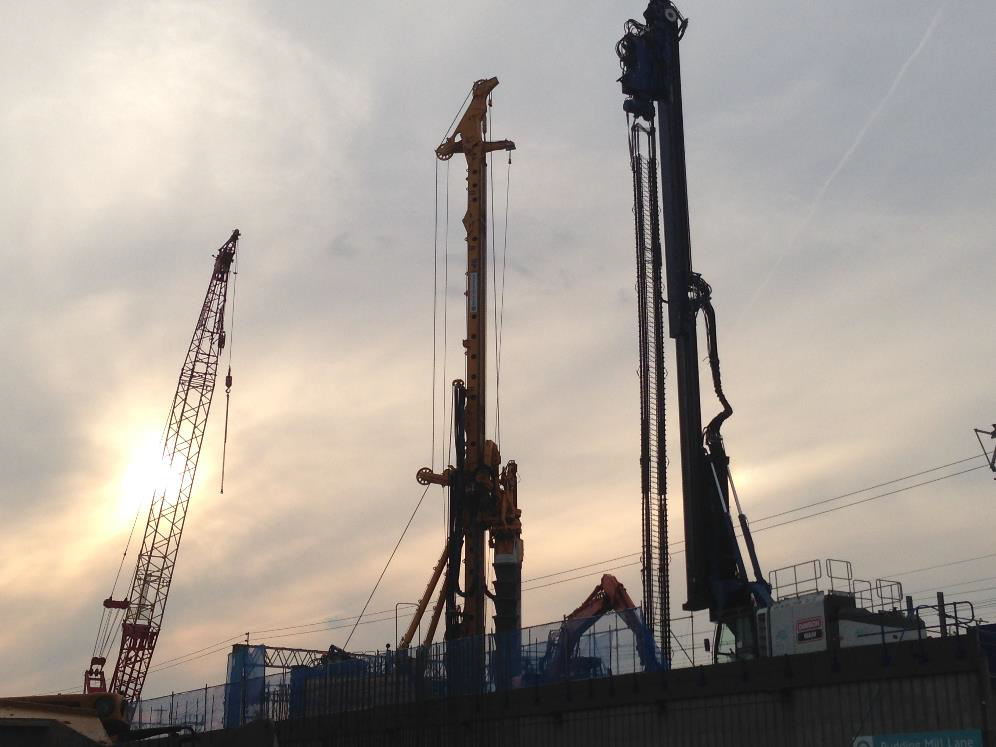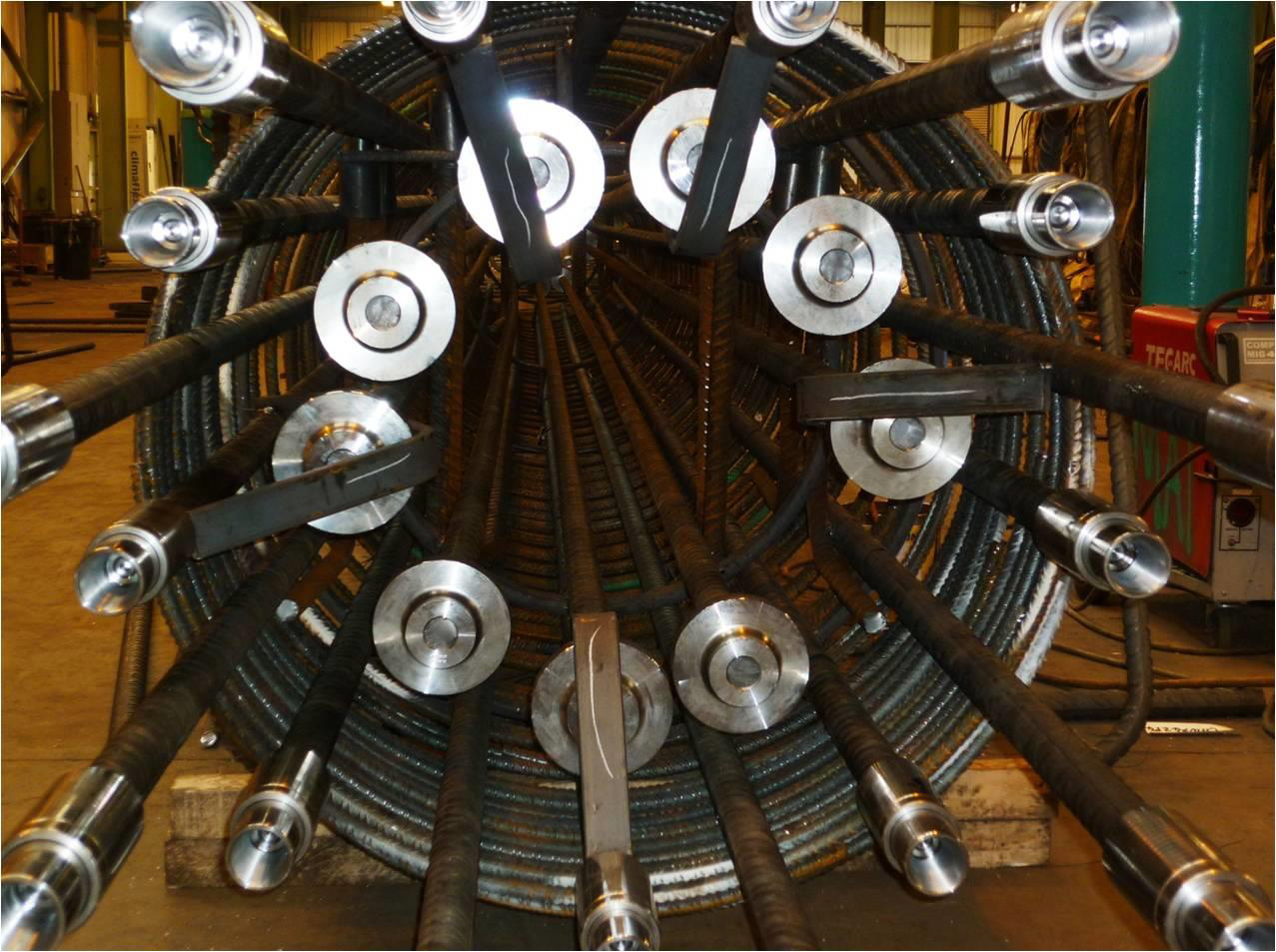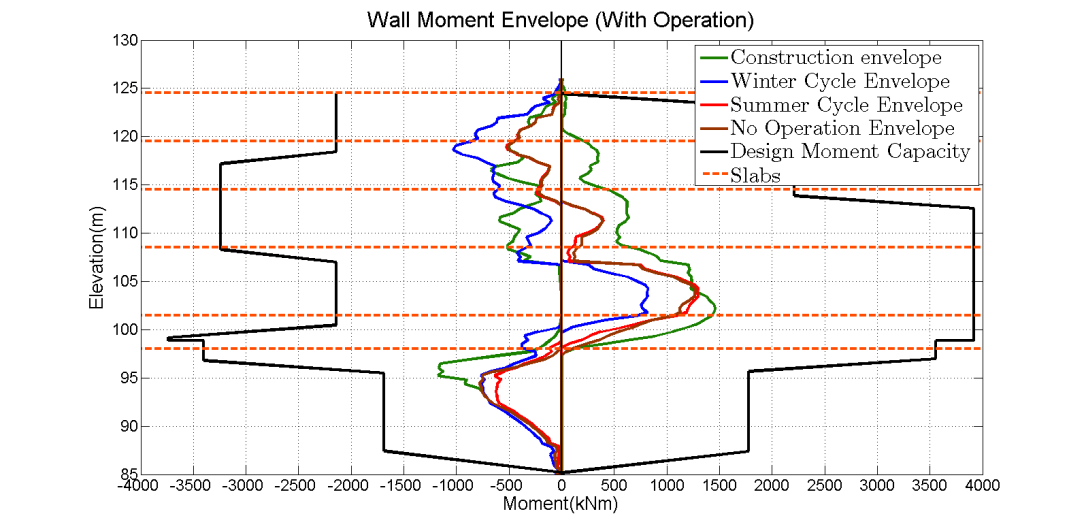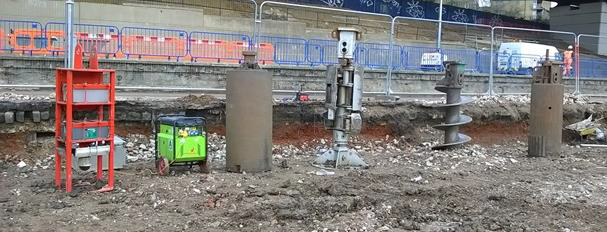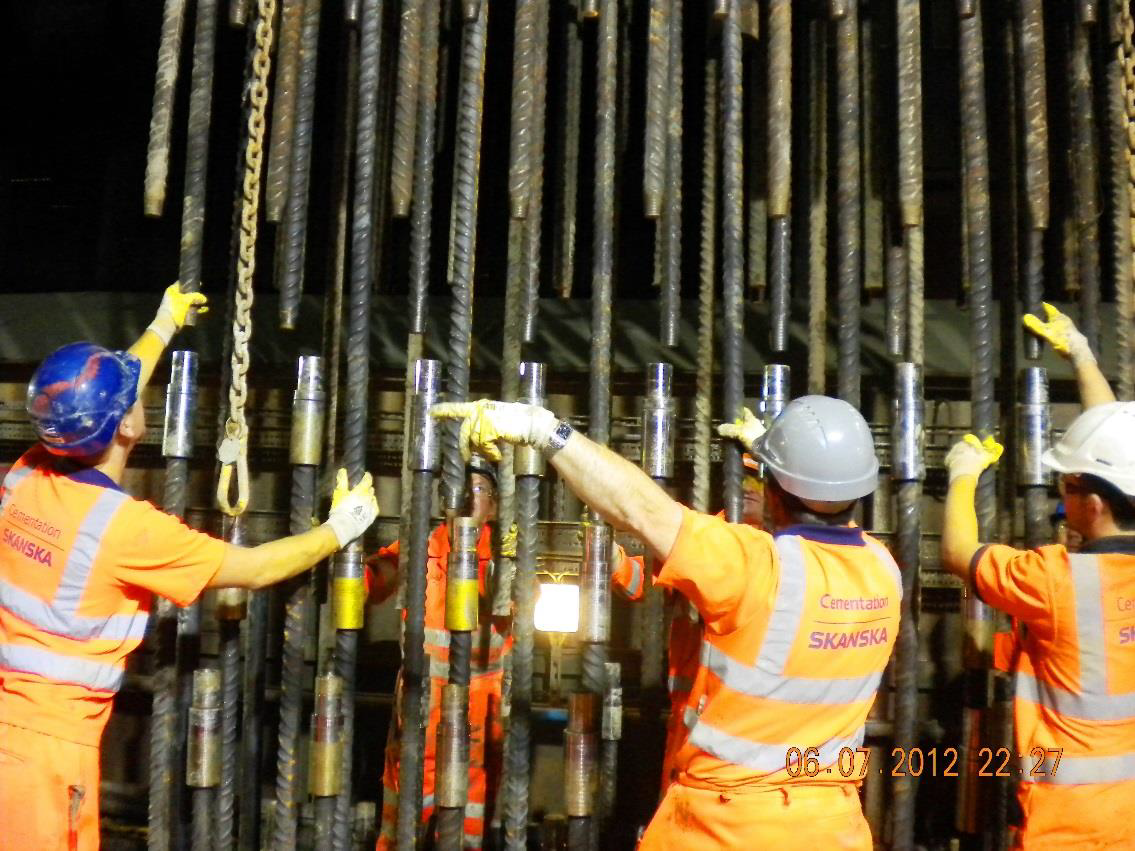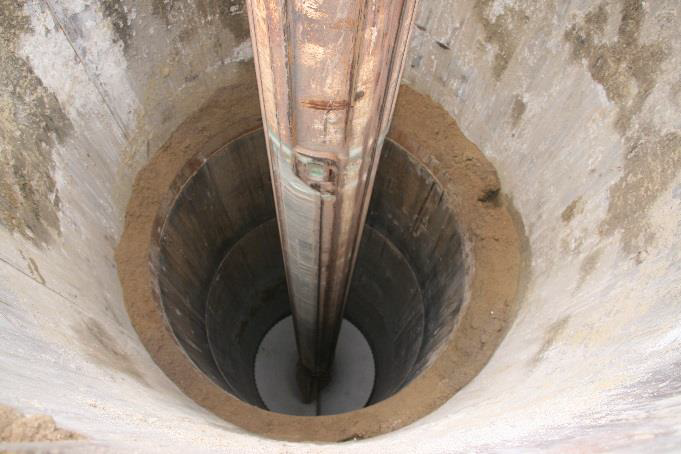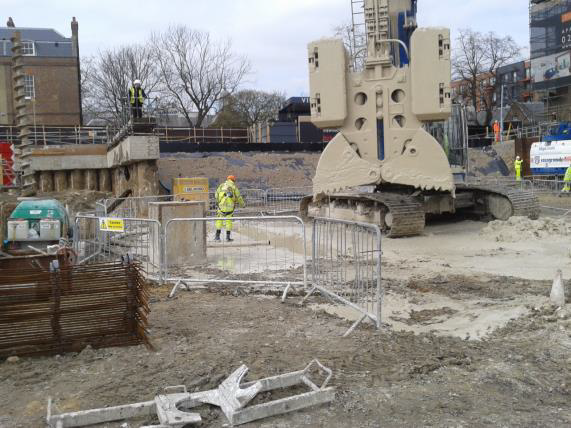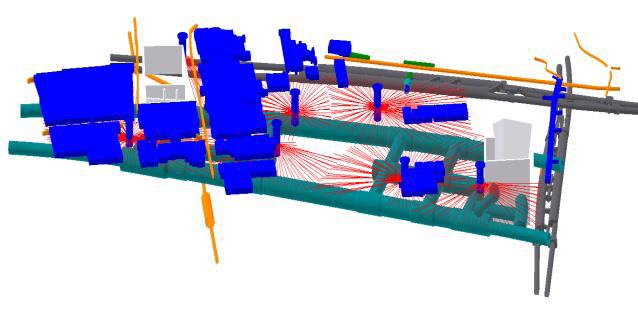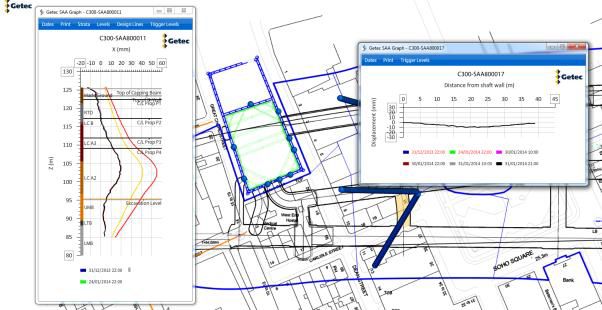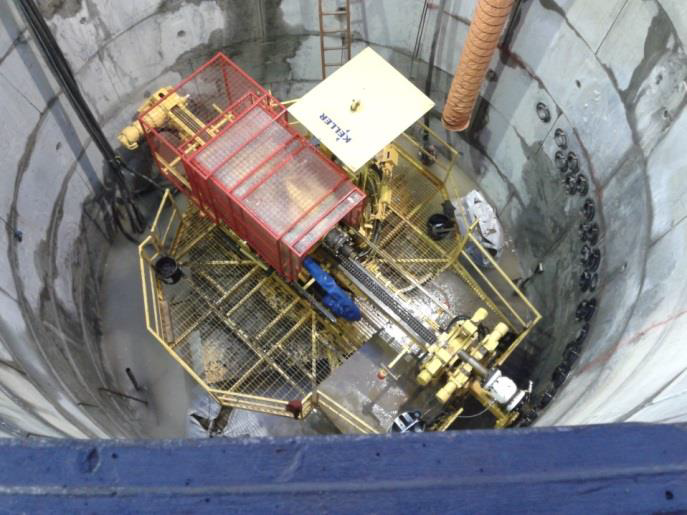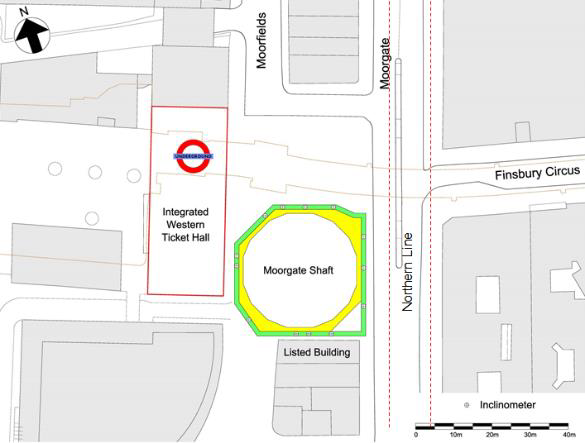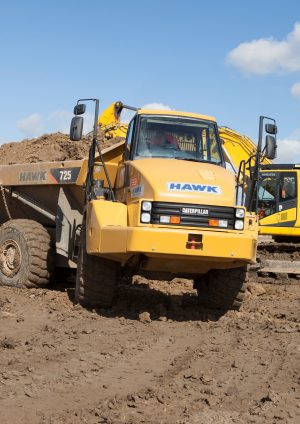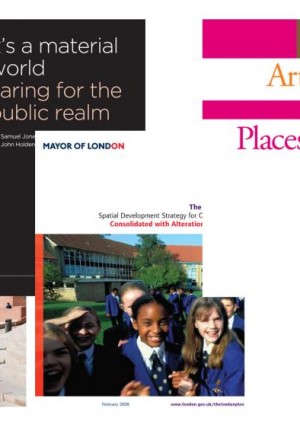| Summary |
Publication date |
Document Type |
Topic area: Civil Engineering This dataset includes ground movement monitoring close-out reports prepared by Crossrail contractors during tunnelling.
These are shared with the aim of assisting better understanding of soil structure interaction and control for future tunnelling projects in London ground conditions.
|
17/05/2023 |
Dataset |
Topic area: Civil Engineering The Elizabeth line traverses some of London’s most dense and evolving metropolitan areas. Safeguarding of the route has played an important part since the identification of a tunnelled route back in the early 1990s, following promoters’ recognition of the need to preserve and protect necessary building space and to...
|
14/02/2023 |
Technical Paper |
Topic area: Civil Engineering Extensive prototyping was carried out during the design and delivery of the Elizabeth line for the line-wide architectural components. Previous papers have covered the process of client prototyping and its key benefits. This paper concentrates on the prototyping carried out by the contractors during the construction st...
|
03/12/2020 |
Journal Publication |
Topic area: Civil Engineering A suspected and previously unknown Drift Filled Hollow (DFH) was tentatively identified during the site investigation works for the Crossrail project in the Moorgate area. This feature was later confirmed and exposed during the construction of Moorgate Box and neighbouring Crossrail tunnels. This paper explains the cha...
|
09/07/2018 |
Technical Paper |
Topic area: Civil Engineering Escalator shafts are essential for underground stations as they provide access from ticket halls typically at surface level to the deep platform tunnels. The design and construction of these inclined tunnels can present as many or more challenges during the design and construction compared to horizontal tunnels.
The ne...
|
09/07/2018 |
Technical Paper |
Topic area: Civil Engineering Crossrail Contract C121’s scope is the design of the SCL (sprayed concrete lining) permanent structures of five new underground stations (Liverpool St, Whitechapel, Tottenham Court Road, Bond Street and Farringdon), shafts and three crossovers. Mott MacDonald was appointed to carry out this work. This paper describes...
|
09/07/2018 |
Technical Paper |
Topic area: Civil Engineering The Stepney Green Crossrail site consists of a box shaft connected to two underground sprayed concrete lined (SCL) tunnels. The two tunnels (eastbound and westbound) comprise large SCL caverns, with the largest cross-section being 13.7 m high and 16.9 m wide. The tunnels also contain lengths of smaller diameter, which ...
|
09/07/2018 |
Technical Paper |
Topic area: Civil Engineering The UK London Crossrail project was devised to improve transportation links across a city faced with an increasing population density and a growing demand for greater public transport utilisation. The central section of the Crossrail project across the city has been constructed almost entirely underground. It will prov...
|
09/07/2018 |
Technical Paper |
Topic area: Civil Engineering This paper focuses on the fire design strategy that has been set up for permanent tunnel linings (secondary linings), with regard to their structural capacity under a fire event. This design is part of Crossrail Contract C121’s scope (Sprayed Concrete Tunnels, SCL tunnels), undertaken by Mott MacDonald.
The paper des...
|
09/07/2018 |
Technical Paper |
Topic area: Civil Engineering The Elizabeth line, due to open in December 2018, crosses London from west to east. The Crossrail project to construct the Elizabeth line has seen 21km of twin-bored tunnels constructed under central London, with eight new stations built on this section.
The damage assessment and monitoring carried out comprised a sign...
|
02/07/2018 |
Journal Publication |
Topic area: Civil Engineering The new Elizabeth line station at Tottenham Court Road, delivered by the Crossrail programme, has been an exercise in interface management as well as a feat of engineering.
This paper describes the design carried out by the Arup Atkins Joint Venture (AAJV) under contract C134, principally of the Western Ticket Hall bo...
|
02/07/2018 |
Journal Publication |
Topic area: Civil Engineering Tottenham Court Road Elizabeth line station is a new station located in the heart of London, adjacent to Oxford Street, being delivered as part of the Crossrail programme. The station is expected to accommodate more than 200,000 passengers every day when it becomes operational in December 2018. The station is of pa...
|
02/07/2018 |
Journal Publication |
Topic area: Civil Engineering The St Giles Circus project involves the £150M redevelopment of a central London site adjacent to Tottenham Court Road Station (Figure 1). The structural and civil engineering design was undertaken by Engenuiti, with geotechnical advice from Donaldson Associates. The development includes leisure, retail, commercial...
|
02/07/2018 |
Journal Publication |
Topic area: Civil Engineering Canary Wharf was the first station on the Elizabeth line to be constructed, and the first
to be let as a design-and-build contract, with developer Canary Wharf Group. Innovative design and construction techniques enabled the station box to be completed four months ahead of the development programme. Construction of the...
|
02/07/2018 |
Journal Publication |
Topic area: Civil Engineering Farringdon is one of eight new underground stations being built in central London for the Elizabeth line and will be one of the key interchange stations on the new line. Upon completion, over 140 trains per hour will pass through the Farringdon interchange, making it one of Britain’s busiest stations. With Thameslink...
|
02/07/2018 |
Journal Publication |
Topic area: Civil Engineering The new Elizabeth line station at Custom House was a unique opportunity for design and construction. It is the only above-ground station on the central section of the line and will welcome millions of visitors to London’s largest conference centre, ExCeL, as well as providing vital connections for the Borough of Newh...
|
02/07/2018 |
Journal Publication |
Topic area: Civil Engineering The design of Bond Street Elizabeth line station has evolved over 10 years of design and construction work. This article explains how the design has developed over this timeframe and how the independent designs for two clients were successfully delivered on the same site. It will discuss how the site constraints have i...
|
02/07/2018 |
Journal Publication |
Topic area: Civil Engineering This recorded presentation describes Crossrail’s experience of GBRs from the client’s perspective. It covers why Crossrail adopted GBRs, where they were adopted and summarises how they were adopted.
A semi quantitative assessment of the performance of the GBRs is then presented along with an analysis of the types o...
|
17/05/2018 |
Video |
Topic area: Civil Engineering On a project the size and complexity of Crossrail there is much interest from professionals from all industries in learning how such a project implements new and innovative processes and different ways of working. To this end it was expected that employees and contractors would be requesting to deliver papers and journ...
|
13/03/2018 |
Micro-report |
Topic area: Civil Engineering The protection of the Docklands Light Railway (DLR) River Lea Viaduct in East London became the subject of extensive scrutiny as temporary groundwater control was undertaken for cross-passage 14 construction on the Crossrail project. Dewatering was required to facilitate the safe construction of the cross-passage which...
|
30/09/2017 |
Technical Paper |
Topic area: Civil Engineering This document sets out to record Crossrail’s experience of the use of Geotechnical Baseline Reports (GBRs) in its construction contracts. In reading this report it is important to remember that in all of the major Crossrail Civil Engineering contracts Contractor design activities were limited to temporary works only....
|
30/09/2017 |
Technical Paper |
Topic area: Civil Engineering After completion of primary lining construction for the Whitechapel Crossover, a value engineering exercise was undertaken to save time within the overall construction programme and Crossrail’s overall critical path for the completion of the tunnels, platform tunnel fit out and construction of track-slab through the ...
|
30/09/2017 |
Technical Paper |
Topic area: Civil Engineering This paper outlines the findings from the design experience of mainly escalator tunnels above a foam concrete backfilled temporary access tunnel, and/or below a partially backfilled pilot tunnel because of the pilot tunnel axis is much higher than the enlarged ones. 2D FLAC numerical analysis with full geological and g...
|
30/09/2017 |
Technical Paper |
Topic area: Civil Engineering The aim of this paper is to describe the factors within a tunnel environment that may contribute toward a corrosive atmosphere, and considering these, to determine the corrosivity of the atmosphere throughout a tunnel environment and present methods to mitigate against corrosive damage.
There are various factors that c...
|
30/09/2017 |
Technical Paper |
Topic area: Civil Engineering The Crossrail route will run for more than 100 km from Reading and Heathrow in the west, through new twin-bore 21 km tunnels under central London, to Shenfield and Abbey Wood in the east. Crossrail has the requirement for crossovers, one of which was provided at Fisher Street – a small site between Tottenham Court Ro...
|
30/09/2017 |
Technical Paper |
Topic area: Civil Engineering Proving that something doesn’t exist can be as important as proving that something does exist and the example of perceived noise in monitoring systems can fall into both scenarios.
Cities all over the world are growing and one of the greatest challenges facing us as engineers is how to increase and improve infrastruc...
|
30/09/2017 |
Technical Paper |
Topic area: Civil Engineering Like many major urban centres, London is faced with an ever increasing population and the need to transport people safely and efficiently across a sprawling city landscape. The Crossrail project will provide an East-West link from the suburbs and across the city enabling an additional 200 million journeys each year lin...
|
30/09/2017 |
Technical Paper |
Topic area: Civil Engineering Crossrail is delivering the Elizabeth line which is due to open in central London from 2018. The new railway includes 42km of tunnels underneath the city.
In sensitive sections of the tunnel network, noise and vibration impacts from the operating railway had to be minimised. The solution was a high density floating tra...
|
26/09/2017 |
Video |
Topic area: Civil Engineering Instances of the use of InSAR on the Crossrail project are presented in this case study and the process of working with InSAR data via GIS software is reviewed. Advantages of InSAR include its low cost relative to other techniques, its ability to monitor large areas and the availability of historical data. The limitati...
|
19/09/2017 |
Case Study |
Topic area: Civil Engineering This paper discusses the use of sprayed concrete linings on the Crossrail project to deliver the Elizabeth east–west railway line across London. It describes how sprayed concrete linings have been successfully used, leading to significant programme and cost savings to the project. Sprayed concrete linings have been...
|
24/03/2017 |
Journal Publication |
Topic area: Civil Engineering This paper describes the design management for the central tunnelled section of the £14·8 billion Crossrail project to deliver the Elizabeth line east–west railway across London. It explains why the processes, procedures and areas of responsibilities of the designers and employer needed to be robust and resilient...
|
24/03/2017 |
Journal Publication |
Topic area: Civil Engineering Temporary dewatering was necessary at some Station, Portal, Shaft and Cross Passage construction sites to ensure ground stability, to control inflows into open excavation and to allow safe construction.
The potential effects of these temporary dewatering works were anticipated in the Project Environment Statement (ES)....
|
14/03/2017 |
Dataset |
Topic area: Civil Engineering This paper describes some of the key challenges and lessons learned in creating a deep-mined, sprayed-concrete lined station shell for London’s new Elizabeth line. Tottenham Court Road station was one of five such stations in the £14·8 billion Crossrail project to deliver a new 118 km east–west railway across the...
|
14/03/2017 |
Journal Publication |
Topic area: Civil Engineering The links provide access to two documents produced by GCG for Crossrail; a geological long section along the Crossrail alignment in London; and a report that provides detailed notes for the section along with some context for the production of the section.
Prior to construction of Crossrail a large number of ground in...
|
14/03/2017 |
Dataset |
Topic area: Civil Engineering Understanding the ground and the specific geotechnical risks it presented was critical for successful delivery of Crossrail, the £14·8 billion project to deliver the Elizabeth line east–west railway across London, UK. Focusing specifically on the central tunnelled section, this paper describes the broad geological ...
|
14/03/2017 |
Journal Publication |
Topic area: Civil Engineering The 42 km of tunnels constructed using soft-ground pressure-balance tunnel-boring machines for London’s new Elizabeth line were completed over a 3 year period. A single lining design solution was developed for all tunnels using a fully gasketed, steel-fibre-reinforced, concrete segmental lining suitable for use in ...
|
14/03/2017 |
Journal Publication |
Topic area: Civil Engineering The platform and pedestrian tunnels for the Crossrail Stations at Whitechapel and Liverpool Street have been constructed using Sprayed Concrete Lining techniques more than 30 m below the congested urban streets of London. Pre-construction ground investigations indicated that the tunnels would be formed predominantly in...
|
31/12/2016 |
Technical Paper |
Topic area: Civil Engineering This report sets out the geological conditions at each Crossrail TBM launch or reception location and summarises any ground treatment and/or dewatering requirements that were applied as a result.
|
31/10/2016 |
Micro-report |
Topic area: Civil Engineering 19 cross passages have been constructed between the two Crossrail running tunnels. Information about the geological conditions, the form of construction and the nature of any ground treatment or dewatering at each cross passage is presented here for reference. It will be of interest to designers and contractors constru...
|
27/09/2016 |
Dataset |
Topic area: Civil Engineering A link passage between Crossrail’s Bond Street station and London Underground’s Bond Street station was constructed to allow pedestrian access between the two. To enable this, an existing ventilation tunnel from the Central line needed to be diverted.
The preliminary design was carried out by the LU Station upgrade...
|
31/08/2016 |
Technical Paper |
Topic area: Civil Engineering The complexity and the unknowns of the geology at Farringdon, primarily associated with the Lambeth Group, required a state-of-the-art geotechnical approach in order to manage the risks related to the open face, sprayed concrete lining (SCL) tunnelling. This was aided by the 3D geological model developed by the British...
|
31/08/2016 |
Technical Paper |
Topic area: Civil Engineering Current TBM Monitoring systems are set to respond to settlement monitoring results that are, at best, reported the next day. If something is really wrong then it is too late.
TBMView system can show trends and highlight errors and over excavation as it is happening and whilst there is still a chance to avoid the settle...
|
31/08/2016 |
Technical Paper |
Topic area: Civil Engineering During construction of the sprayed concrete lined tunnels at Bond Street and Tottenham Court Road Crossrail stations, a number of challenging conditions were encountered, including known and unknown obstructions, and adverse ground conditions. This included uncharted historical wells at both sites discovered only durin...
|
31/08/2016 |
Technical Paper |
Topic area: Civil Engineering In modern design of complex tunnelling projects it is best practice to utilise 3D finite element analysis (3D FEA), its main advantage being the ability to capture the impact of the actual construction processes and the very influential three dimensional effects. The latter may include the effect of tunnels constructed...
|
31/08/2016 |
Technical Paper |
Topic area: Civil Engineering This paper evaluates the influence of Crossrail tunnelling works on selected buildings at Bond Street. The monitoring results of ground and building deformation and damage observed during the works are analysed and compared to those developed using the analytical and empirical methods.
The monitoring results showed evi...
|
31/08/2016 |
Technical Paper |
Topic area: Civil Engineering A systematic compensation grouting scheme was successfully implemented to mitigate the surface settlements caused by the tunnelling works in Crossrail’s Farringdon Station. Concurrent grouting episodes were carried out simultaneously with the sequential excavation of the tunnels comprising injections both in front of...
|
31/08/2016 |
Technical Paper |
Topic area: Civil Engineering Long-term settlement at the start of the project was considered marginal and was believed to not be significant in comparison to the magnitude of the direct settlement influence from tunnel excavation. However, long-term effects of SCL tunnelling at Crossrail C510 Whitechapel and Liverpool Street Stations were identifi...
|
31/08/2016 |
Technical Paper |
Topic area: Civil Engineering Falling ground or immature concrete within sprayed concrete lined tunnels is a major safety risk to personnel, which has complex inter-relationships of design, workmanship, plant and materials contributing to any single event. With experience of over 12km of SCL tunnelling on Crossrail in London, this paper describes t...
|
31/08/2016 |
Technical Paper |
Topic area: Civil Engineering Covered Way 126 is a Victorian structure enclosing the London Overground railway at Whitechapel. It consists of masonry abutments supporting cast iron roof beams and masonry jack-arches. It is close to Crossrail tunnels and box excavations, and was expected to be affected by ground movements during Crossrail construc...
|
31/08/2016 |
Technical Paper |
Topic area: Civil Engineering Providing parallel access into tunnels during its construction is a key factor for optimising programme. However a tunnel is a linear work site where sharing of the space between several contractors brings with it interfacing issues and associated risks that may in turn negate the benefit gained from parallel working.
...
|
31/08/2016 |
Technical Paper |
Topic area: Civil Engineering Methods of monitoring the structural behaviour of tunnels during construction traditionally rely on in-tunnel displacement monitoring, with designers occasionally specifying the use of pressure cells in critical areas. The advent of fibre optic strain technology (using Fibre Bragg Gratings) offers the tunnelling indust...
|
31/08/2016 |
Technical Paper |
Topic area: Civil Engineering A joint venture of BAM, Ferrovial and Kier (BFK) have constructed the station tunnels at both Bond Street and Farringdon Stations, as part of Crossrail contracts C410 and C435 respectively. These tunnels were all excavated and supported with a sprayed concrete primary lining.
The secondary linings at Bond Street and Fa...
|
31/08/2016 |
Technical Paper |
Topic area: Civil Engineering Crossrail is a 21km tunnelling project under London from Paddington in the west and Pudding Mill Lane and Plumstead in the east. The entire sequence of London Basin geology is traversed along the route including the deep aquifer. Ground investigations began in the first phase of Crossrail during the 1990’s and contin...
|
31/08/2016 |
Technical Paper |
Topic area: Civil Engineering This paper discusses how the Whitechapel Project Team overcame issues regarding the inclusion of foreign material in the Diaphragm Wall panels at Cambridge Heath Shaft, Whitechapel Crossrail station. The shaft is circular in shape and formed of Diaphragm Walls with an internal diameter of 28.0 m and a depth of 32 m. It...
|
31/08/2016 |
Technical Paper |
Topic area: Civil Engineering The design of the tunnels at Crossrail’s Bond Street Station (C300/C410) includes a final sprayed concrete fireproofing layer. This layer covers any protruding steel fibres in the secondary lining and provides passive fire protection to the tunnel structure.
The ability of this regulating layer to limit spalling in t...
|
31/08/2016 |
Technical Paper |
Topic area: Civil Engineering The sprayed concrete lined (SCL) tunnels in Crossrail Farringdon Station have been mainly excavated in the Lambeth group, a highly variable formation comprising generally very stiff, over-consolidated clays with interbedded sand lenses. The platform tunnels, approximately 11.4m wide by 10.6m high, were enlarged from th...
|
31/08/2016 |
Technical Paper |
Topic area: Civil Engineering The idea for this short paper arose from the views and encouragement of colleagues working on the Crossrail Project. The geological sequences under London were well understood by all the Engineers and Tunnellers the author encountered but sometimes lacked the purely geological insight in to why things are the way they ...
|
31/08/2016 |
Technical Paper |
Topic area: Civil Engineering This paper presents observations and monitoring results of ground movements arising from construction of the Crossrail Contract C310 tunnels and its subsequent impact on a large diameter concrete inlet.
The Store Road Inlet, a newly constructed 2.4m diameter concrete pipe inlet to a major pumping station in the London ...
|
31/08/2016 |
Technical Paper |
Topic area: Civil Engineering At 260 metres long and at a depth of 26 metres, the platform tunnels for Crossrail’s Bond Street Station sit below some of the most expensive real estate in the world. Excavated in London Clay, the platform tunnels were formed first by segmental lining from the passing of two Earth Pressure Balance (EPB) Tunnel B...
|
31/08/2016 |
Technical Paper |
Topic area: Civil Engineering The C310 Thames Tunnel comprises twin 2.72km long bored tunnels between North Woolwich and Plumstead Portal. Four cast in-situ cross passages link the tunnel drives and the junction between the running tunnels and cross passage linings are made by RC collars cast in-situ on the primary sprayed concrete lining (SCL). Si...
|
31/08/2016 |
Technical Paper |
Topic area: Civil Engineering The CRL project has dedicated more than £150 Million to the complete life cycle of automated optical monitoring of rail assets. These optically based systems have been the primary source of monitoring in the majority of all Crossrail’ s interfaces with existing railway infrastructure and each construction contract h...
|
31/08/2016 |
Technical Paper |
Topic area: Civil Engineering The flagship Crossrail Paddington Station is generally located within London Clay and takes the shape of a deep cut and cover underground box structure approximately 264 m long, 24 m wide and 24 m deep framed with diaphragm walls and constructed top down using plunge columns connected to 1.8 m diameter bored piles. It ...
|
31/08/2016 |
Technical Paper |
Topic area: Civil Engineering This paper provides a comparison of predicted and measured displacements and deformations for SCL tunnels at Crossrail C510 Whitechapel Station. It contributes to the current “lesson learnt” discussion on Crossrail projects in terms of design optimisation. The paper shall feed this discussion with thoroughly invest...
|
31/08/2016 |
Technical Paper |
Topic area: Civil Engineering Shortest of all C305 running tunnel drives, Drive G had the most complex geology, steepest vertical gradient, shallowest cover at Victoria Dock Portal (VDP) and the most complicated with Third Party assets on C305.
At VDP, as the tunnel alignment rose toward the portal, the crown rose into superficial deposits above th...
|
31/08/2016 |
Technical Paper |
Topic area: Civil Engineering The Moorgate shaft at Crossrail Liverpool Street station is one of the deepest in London. Construction of the base slab to the shaft required close collaboration between the client, designer, contractor and suppliers to give assurance that the slab was watertight. Dense reinforcement was detailed to ensure ease of ...
|
31/08/2016 |
Technical Paper |
Topic area: Civil Engineering Liverpool Street station was on the critical path for the completion of Crossrail’s central tunnelled section; however the start of the station’s 42m deep Moorgate shaft was delayed by the prolonged time required to extract the foundation piles of the building that had previously occupied the site. As this delay ...
|
31/08/2016 |
Technical Paper |
Topic area: Civil Engineering 3D numerical models require significant effort for their preparation and analysis, translated into time and cost. It is in the hands of the engineer to set the optimal level of simulation detail that will provide a reliable and cost effective solution. In sprayed concrete lined tunnels, a common simplification is to si...
|
31/08/2016 |
Technical Paper |
Topic area: Civil Engineering Creating a complex sprayed concrete lined (SCL) crossover between the Crossrail running tunnels at Fisher Street presented the project team with many interesting challenges, constructing 15m wide caverns beneath sensitive London buildings but without the provision for Compensation Grouting.
The paper describes these ch...
|
31/08/2016 |
Technical Paper |
Topic area: Civil Engineering The C435 Farringdon Station Crossrail Project is currently under construction by BAM Ferrovial Kier Joint Venture (BFK). Significant settlements were anticipated, primarily as a result of deep shaft construction, and a combination of Tunnel Boring Machine (TBM) and Sprayed Concrete Lining (SCL) tunnelling. The method o...
|
31/08/2016 |
Technical Paper |
Topic area: Civil Engineering InSAR (Interferometric Synthetic Aperture Radar) is a technology used worldwide in order to carry out ground motion surface monitoring without in-situ intervention, using data from radars on Polar-orbiting satellites. Persistent Scatter Interferometry (PSI) based algorithms are the conventional tools used for the detec...
|
31/08/2016 |
Technical Paper |
Topic area: Civil Engineering The Crossrail station at Liverpool Street, London required the downward construction of a 37m long by 6m diameter inclined ventilation tunnel using sprayed concrete lining (SCL) techniques. The tunnel penetrated into water bearing channel sands present in the Lambeth Group below the London Clay. This paper describes th...
|
07/09/2015 |
Technical Paper |
Topic area: Civil Engineering This paper describes the approach taken to analyse, predict and monitor the behaviour of segmentally lined tunnels resulting from deep basement excavation directly above.
The Crossrail Paddington Station comprises a 24m deep box structure located entirely within London Clay. Prior to box excavation, twin 6.8m diamete...
|
07/09/2015 |
Technical Paper |
Topic area: Civil Engineering Crossrail will provide a high frequency, high capacity train service serving 40 stations and linking Reading and Heathrow in the west of London, to Shenfield and Abbey Wood in the east. Over-ground sections of the route will be linked via twin, 21km tunnels up to 40m below central London and involving the excavation ...
|
07/09/2015 |
Technical Paper |
Topic area: Civil Engineering The underground construction of the Crossrail Western Running Tunnels saw two 7.1m diameter Earth Pressure Balance (EPB) Tunnel Boring Machines (TBM) bore the twin running tunnels beneath central London.
From launch at Royal Oak in mid-2012, the two TBMs continued eastward to the Crossrail Farringdon Station constructi...
|
07/09/2015 |
Technical Paper |
Topic area: Civil Engineering In 2011 BBMV C510 Joint Venture was awarded the contract for the construction of the Vallance Garden Crossover tunnel. Originally the Crossover was located in Fisher Street, but in 2011 it was relocated to the Vallance Garden area. Due to a lack of geological information a total of 9 bore holes were drilled in order to...
|
07/09/2015 |
Technical Paper |
Topic area: Civil Engineering The Crossrail project in London is currently the largest infrastructure project in Europe. The contract C510 comprises the construction of two underground stations in sprayed concrete lining (SCL), Liverpool Street and Whitechapel. Based on the absolute priority of health and safety during all construction phases and s...
|
07/09/2015 |
Technical Paper |
Topic area: Civil Engineering From its unveiling in 1927, the Post Office tunnel provided much of London’s mail and parcel transportation across the city, all the way up to its suspension in 2003. Since then, it has remained an historic asset of London. During the construction of Crossrail at Liverpool Street, SCL Tunnelling has been expected to ...
|
07/09/2015 |
Technical Paper |
Topic area: Civil Engineering Crossrail contract C300/C410 involved the construction of a number of SCL tunnels at Bond Street and Tottenham Court Road Stations, and the Fisher Street crossover as well as six cross passages between the two running tunnels built under this contract. Assessment of the short term stability of the London Clay Formation...
|
07/09/2015 |
Technical Paper |
Topic area: Civil Engineering To understand the behaviour of the tunnel lining and the ground during the construction of tunnels and shafts is not only important to determine vertical displacement in the ground but also in the horizontal direction, perpendicular and parallel to the SCL-tunnels. A series of inclinometers were installed at Liverpoo...
|
07/09/2015 |
Technical Paper |
Topic area: Civil Engineering Underground construction projects in inner city environments inevitably induce surface and sub-surface ground movements. The detection and management of these ground movements is essential in order to maintain a safe environment for inhabitants inside the zone of influence and to protect all existing infrastructure and...
|
07/09/2015 |
Technical Paper |
Topic area: Civil Engineering Two additional temporary sprayed concrete lining (SCL) structures were designed in addition to the base design, and constructed for Crossrail at Farringdon Station. These structures, namely a wraparound (PL2RC) and a temporary connection adit (CP1-CH1), allowed for significant optimisation of the construction programme...
|
07/09/2015 |
Technical Paper |
Topic area: Civil Engineering Accurate ground water monitoring is vital during tunnel excavation in soft soils, not only for the stability of the excavation itself, but also for possible induced settlements, especially in urban areas like London where the total amount of allowed settlement is limited. After the first construction stages of Liverpoo...
|
07/09/2015 |
Technical Paper |
Topic area: Civil Engineering The maximum allowable settlement under the load conditions defined by the specified load model is 15mm, the first 10mm of which is assumed to take place during the construction phase under essentially static loads and the balance under live (i.e. train-imposed) loads generated during the working life of the structure.
...
|
07/09/2015 |
Technical Paper |
Topic area: Civil Engineering A key bid-winning innovation introduced by BAM Ferrovial Kier (BFK) joint venture on the combined Crossrail Contract C300/C410 was the change of sequence for station construction to allow the TBMs to pass through the stations prior to completion of the SCL works at Bond Street and Tottenham Court Road stations. This no...
|
07/09/2015 |
Technical Paper |
Topic area: Civil Engineering Predictions of ground movements due to tunnelling extensively rely on empirical methods based on published case studies of tunnels constructed in similar ground conditions. Prediction of ground movement is necessary to estimate the risk to not only the constructed tunnel, but to workers in the tunnel as well as the ris...
|
07/09/2015 |
Technical Paper |
Topic area: Civil Engineering Connaught Tunnel – situated midway between Custom House and North Woolwich and formerly part of the North London Line infrastructure where it passed beneath the Royal Docks in East London – is a Victorian (i.e. 19th Century) brick-lined structure that has been renovated to facilitate the route of the South-...
|
07/09/2015 |
Technical Paper |
Topic area: Civil Engineering Farringdon Crossrail, a key interchange station is one of the eight new underground stations being built through central London. The purpose of this paper is to describe a number of key design features of the underground station which is being constructed on very constrained sites in central London adjacent to historic...
|
07/09/2015 |
Technical Paper |
Topic area: Civil Engineering The Crossrail project is a new underground railway crossing London from west to east. The project involves the construction of 21km of twin bore tunnel and 8 new underground stations. In the east the route alternates between surface and tunnel by utilising the former North London Line route through Silvertown and North...
|
07/09/2015 |
Technical Paper |
Topic area: Civil Engineering Crossrail will provide a high frequency, high capacity train service serving 40 stations and linking Reading and Heathrow to Shenfield and Abbey Wood. The central section is underground, at up to 40m depth, comprising 2x 6.8m external diameter bored tunnels over a 21km length, and 9 stations. The tunnels encounter or...
|
07/09/2015 |
Technical Paper |
Topic area: Civil Engineering Soil conditioning is an important part of the tunnelling process with Earth Pressure Balance (EPB) TBMs. It is used to modify the properties of the excavated soil to improve control of the excavation process and the TBM performance. Conditioning agents such as water, foam and polymers are injected to the soil during ex...
|
07/09/2015 |
Technical Paper |
Topic area: Civil Engineering As computer technology has evolved in the recent years, numerical modelling appears to be an increasingly preferable solution in all engineering fields, including tunnelling. The finite element method has become one of the standard tools and proves to indeed be very useful for the analysis of complex underground struct...
|
07/09/2015 |
Technical Paper |
Topic area: Civil Engineering Two adjacent deep shafts in east London involved excavation to 30 m below standing groundwater level and required temporary control of pressures in the Lower Aquifer below the London Clay. Three distinct aquifer horizons were present comprising the Lambeth Group channel sands, Thanet Sand and Chalk. One of the shafts w...
|
07/09/2015 |
Technical Paper |
Topic area: Civil Engineering The displacements of sprayed concrete lining must be measured during tunnel excavation. In order to assess stability the displacements are checked against predictions. Generally, if the measured displacements are equal or less than the predictions, stable and safe conditions are assumed.
However, just looking at single...
|
07/09/2015 |
Technical Paper |
Topic area: Civil Engineering In a unique arrangement Berkeley are collaborating with Crossrail Ltd (CRL) to deliver the Royal Arsenal Woolwich Station Box. In order to construct the Box initial ground investigation was required as well as site clearance and multiple utility service diversions. The most complex of the utility diversions was the div...
|
03/11/2014 |
Technical Paper |
Topic area: Civil Engineering Site investigation works undertaken as part of the Crossrail project over the last ten years have involved extensive intrusive works into the ground in areas of London which were known to have been heavily bombed during World War Two. This bombing created a legacy of unexploded ordnance risk to such works. This paper e...
|
03/11/2014 |
Technical Paper |
Topic area: Civil Engineering The design delivery for the sprayed concrete linings (SCL) for Crossrail contract C300/C410 Western Running Tunnels and Station Caverns has involved a unique set of circumstances.
The SCL primary lining was designed to withstand the various temporary conditions and also formed part of the composite permanent works desi...
|
03/11/2014 |
Technical Paper |
Topic area: Civil Engineering Sprayed concrete lined (SCL) tunnelling has seen rapid development over the last twenty years in the UK. The purpose of this paper is to give an update on the latest design philosophies and methodologies, and to discuss the future development trends for SCL tunnelling in soft ground.
The paper will start with brief ove...
|
03/11/2014 |
Technical Paper |
Topic area: Civil Engineering In Crossrail project contract C310, two new tunnels – the Thames Tunnel (westbound and eastbound) will be constructed between Plumstead portal and North Woolwich portal. The Thames Tunnel is 2.6 km long and about 15 m below the existing Thames river bed. Construction of Plumstead portal commenced in 2011 and complete...
|
03/11/2014 |
Technical Paper |
Topic area: Civil Engineering At over 50m long, 17m wide and 14m high the Stepney Green Caverns are the largest caverns ever built using Sprayed Concrete Lining techniques in Central London. This paper describes the design, construction and monitoring of the Primary Sprayed Concrete Lining together with lessons learnt that can be applied to other C...
|
03/11/2014 |
Technical Paper |
Topic area: Civil Engineering The ground conditions expected at Farringdon Station are amongst the most challenging on Crossrail, exacerbated further by four TBMs (C300 and C305 drives – also known as “X” and “Y” drives respectively) all terminating in reception chambers required to facilitate their extraction. The Sprayed Concrete Lined ...
|
03/11/2014 |
Technical Paper |
Topic area: Civil Engineering Crossrail includes several kilometres of SCL tunnels which were designed by Contract C121, Mott MacDonald supported by Gall Zeidler Consultants. The largest of these SCL tunnels are Stepney Green turnout caverns designed to allow trains from Maidenhead in the west to travel to Shenfield and Woolwich in the east. The ca...
|
03/11/2014 |
Technical Paper |
Topic area: Civil Engineering The purpose of this paper is to summarise the practical applications and benefits of optical fibre based sensors over traditional monitoring systems installed within a sprayed concrete lined tunnel. The installation was undertaken as part of the Crossrail project at Bond Street station East ticket hall. The tunnel cho...
|
03/11/2014 |
Technical Paper |
Topic area: Civil Engineering TBMs are rarely seen out in the open as they are often assembled and launched from portals or shafts with backshunts deep below ground. In some circumstances however, it is necessary to transport these huge machines whole. A task of this scale is a complex procedure and requires careful consideration and planning. The ...
|
03/11/2014 |
Technical Paper |
Topic area: Civil Engineering Crossrail Central includes the construction of eight new underground stations and one new surface station linked together by 21km of new twin bore tunnels. This paper describes some key design features of two of the underground stations at Paddington and Farringdon, both of which have been designed by URS. Both station...
|
03/11/2014 |
Technical Paper |
Topic area: Civil Engineering The measurement of deflection of designed diaphragm walls is critical for near real time information to assess wall and soil behaviour as the internal area is excavated in a controlled manner. Data enables the site team and designers to check performance of the design, which is linked to safeguarding the site and the e...
|
03/11/2014 |
Technical Paper |
Topic area: Civil Engineering As a preliminary part of the Crossrail works at Paddington Station, the existing deck spanning platforms and railway tracks is being transformed from a disused goods depot into a taxi and passenger interchange facility. Paddington Station is a Grade 1 listed heritage structure and all modifications to the existing fabr...
|
03/11/2014 |
Technical Paper |
Topic area: Civil Engineering The ground movement assessment and associated mitigation measures for the National Grid Electric 400kV power cables at Pudding Mill Lane, has been the subject of extensive debate and analysis since the commencement of the Crossrail project.
These power cables are very sensitive to ground movement and hence elaborate sc...
|
03/11/2014 |
Technical Paper |
Topic area: Civil Engineering This paper seeks to compare and contrast observations made of different techniques for drilling horizontal holes within London Clay, and to make recommendations as to how subsequent drilling operations from grout shafts should be undertaken in the future.
The drilling operations discussed in this paper were part of the...
|
03/11/2014 |
Technical Paper |
Topic area: Civil Engineering This paper looks at the sprayed concrete lined (SCL) tunnel design by Mott MacDonald for the Crossrail project. The SCL design consists of five new underground stations, shafts and two Crossovers which will be the largest SCL tunnels to be built in London. It also discusses how the design team was set up and the approa...
|
03/11/2014 |
Technical Paper |
Topic area: Civil Engineering The objective of this paper is to consider the importance of both full scale construction mock-ups and smaller trial samples to a large construction project such as Crossrail. The paper identifies the range of benefits and advantages to be gained by relatively small investment in mock-ups and trial samples and the enha...
|
03/11/2014 |
Technical Paper |
Topic area: Civil Engineering Crossrail Drive X Western Tunnels extend from Westbourne Park to Farringdon Station. With the TBM and SCL contracts working under the most expensive real estate in the world, the safeguarding of assets is paramount for safety and stakeholder’s assurance. The management of instrumentation data from geotechnical works,...
|
03/11/2014 |
Technical Paper |
Topic area: Civil Engineering In recent years the drive to reduce carbon emissions and reliance on oil and gas has led to the increase in the use of renewable energy heating systems. The ground source heat pump systems are an example of these renewable systems. Recently tunnels have been considered as a way of connecting building heat pump systems ...
|
03/11/2014 |
Technical Paper |
Topic area: Civil Engineering The Crossrail Farringdon Station is a deep level station with two platform tunnels, 300 metres long at a depth of approximately 30 metres below street level. The running tunnels are primarily TBM bored with the platform tunnels enlarged using sprayed concrete lining (SCL) tunnelling method. The station is located in ch...
|
03/11/2014 |
Technical Paper |
Topic area: Civil Engineering This paper describes the approach taken to design Crossrail’s precast concrete running tunnel linings for structural stability during a severe fire incident.
In recent decades there have been a number of fire incidents in road and rail tunnels which have caused severe damage to the lining structures. These incidents ...
|
03/11/2014 |
Technical Paper |
Topic area: Civil Engineering A flagship Crossrail structure, the new station at Paddington will be constructed at the heart of one of London’s most significant existing transport hubs. The opportunity to connect Crossrail with international air travel, national mainline, and London transport both above and below ground, drives the need to deve...
|
03/11/2014 |
Technical Paper |
Topic area: Civil Engineering The C300 running tunnels are of comprised a 6.2m internal diameter, 7.1m excavated diameter, and are to be driven by Earth Pressure Balance Machines (EPBMs) from West to East commencing at Royal Oak Portal and terminating at Farringdon Station via Paddington, Bond Street and Tottenham Court Road Stations.
Crossrail TBM...
|
03/11/2014 |
Technical Paper |
Topic area: Civil Engineering Subsurface instrumentation was installed at a field monitoring site in Hyde Park and bordering Bayswater Road for measuring the ground responses to Crossrail tunnelling near Lancaster Gate. Prior to the passage of the tunnel boring machines, pore water pressures were measured, both in the “greenfield” ground and th...
|
03/11/2014 |
Technical Paper |
Topic area: Civil Engineering The proposed Crossrail station will comprise two ticket halls, two escalator/concourse tunnels, two platform tunnels, numerous cross passages and ventilation tunnels. All station tunnels are constructed using sprayed concrete lining (SCL) techniques.
The geological conditions were the principal challenge for the design...
|
03/11/2014 |
Technical Paper |
Topic area: Civil Engineering Lord Hill’s Bridge (LHB) was the first piece of infrastructure that the Western tunnels TBM’s passed beneath, at a depth no greater than 4 m below current ground level. The shallow tunnelling depths are a result of the 100 year old bridge being located 50 m east of the Royal Oak Portal head wall. The bridge itself ...
|
03/11/2014 |
Technical Paper |
Topic area: Civil Engineering Imperial College in collaboration with Crossrail are performing field monitoring research to investigate the effect of tunnelling in London Clay. This is part of an EPSRC-funded research project investigating how tunnelling affects existing tunnels with segmental cast iron linings. The field research involves a compreh...
|
03/11/2014 |
Research Paper |
Topic area: Civil Engineering The protection of third party assets with reliable monitoring instruments is essential for the running of a successful urban tunnelling project. With a twin bore tunnel being excavated below the Ranelagh Sewer, in Paddington for the Western Tunnel drive of Crossrail, a reliable method was required to measure displaceme...
|
03/11/2014 |
Technical Paper |
Topic area: Civil Engineering Sprayed concrete lining (SCL) tunnelling alongside the secant pile walls forming the Eastern Ticket Hall (ETH) box at Bond Street station left a narrow pillar of clay, less than 1m wide in places, between the piles and the tunnel lining. Since the tunnelling was to occur after excavation of the box, the stability of th...
|
03/11/2014 |
Technical Paper |
Topic area: Civil Engineering The redevelopment of Tottenham Court Road Underground Station started in 2011 as part of the Tube Upgrade Plan to improve and increase the capacity of the existing facility. The plan is to upgrade the station by 2016 to meet an estimated demand of more than 200,000 journeys per day once Crossrail is built.
During April...
|
03/11/2014 |
Technical Paper |
Topic area: Civil Engineering Thames Water’s Crossrail Project team required a simple method of predicting ground movements around complex shaped station excavations as a verification tool for the Crossrail 3D FEA based damage assessments.
Existing commercial software did not take into account the corner stiffening effects of box excavations ...
|
03/11/2014 |
Technical Paper |
Topic area: Civil Engineering In October and November 2012, Imperial College installed electrical resistance strain gauge rosettes, potentiometric displacement transducers and tape extensometer eye bolts at selected locations in the Central Line eastbound running tunnel between Lancaster Gate and Marble Arch. The installations were completed before...
|
03/11/2014 |
Technical Paper |
Topic area: Civil Engineering Crossrail includes approximately 10km of Sprayed Concrete Lining (SCL) tunnels. One of the largest of these tunnels is being constructed at Stepney Green, East London to facilitate the construction of a sub-surface junction, allowing Crossrail trains from Maidenhead and the west to travel to Shenfield and Woolwich in t...
|
03/11/2014 |
Technical Paper |
Topic area: Quality Planning with the end in sight is crucial in the delivery of all successful projects, and is especially true in the construction industry, where both the works and personnel involved can change at such a rapid pace.
It is hence crucial to ensure robust pans are in place from the outset, at planning phase of any packa...
|
10/05/2023 |
Technical Paper |
Topic area: Mechanical, Electrical & Public Health This paper covers the engineering design of the platform edge screens for five Elizabeth line tunnel stations in central London. Full-height platform edge screens are a signature feature of the Elizabeth line’s station platforms, and their design presented many challenges. To gain maximum uniformity, the edge screens...
|
02/07/2018 |
Journal Publication |
Topic area: Rail systems The Elizabeth line will use above-ground sections of existing Great Eastern and Great Western tracks between Stratford and Maidenhead where new overhead line equipment (OLE) and traction power supply will be installed.
The OLE is supported by gantries of various types and configurations. In the case of the Great Easter...
|
02/07/2018 |
Journal Publication |
Topic area: Systems Integration and Technical Assurance The architecture of a system can be expressed in conceptual models that represent a system of interest in its environment. It can be framed and described in different views for the perspective of specific system concerns. A system architecture diagram in turn is often used as a work product to communicate these views.?...
|
30/09/2017 |
Technical Paper |
Topic area: Environmental Design Crossrail investigated potential long term uses for the temporary grout shafts excavated to enable mitigation of ground settlement. This micro-report and supporting documents explain the options that were researched, why they could not be implemented by Crossrail and recommends that future projects consider such repurp...
|
31/10/2016 |
Micro-report |
Topic area: Operations Stratford station was the main access for the 2012 Olympic Games and during this event the station was successfully operated with very high passenger numbers. West Ham Football Club will move to the Olympic Stadium for the 2016 season and the station will need to manage the regular football matches without the signific...
|
31/08/2016 |
Technical Paper |
Topic area: Rail systems When a train enters a tunnel, it creates a pressure pulse which is experienced by passengers on the train and which propagates along the tunnel. The pressure pulse results in loads being generated on items of infrastructure, such as platform screen doors and tunnel ventilation equipment.
The tunnel pressure signature i...
|
31/08/2016 |
Technical Paper |
Topic area: Engineering The contract works consisted of piling the foundations for the new DLR station and viaduct in 2011, followed by the extensive piling of the raft transfer slab to support the load of the DLR embankment in 2012.
As additional work in 2012 a diaphragm wall was constructed to infill the gaps left from the previous contract...
|
10/11/2015 |
Technical Paper |
Topic area: Engineering Cementation Skanska Limited (CSL) were employed on a large number of contracts across the Crossrail scheme, including four tunnel portals, three station boxes and one launch shaft. The involvement that Cementation Skanska had on the Crossrail project, when combined with a degree of hindsight, gave CSL a comprehensive o...
|
10/11/2015 |
Technical Paper |
Topic area: Engineering For new building and infrastructure developments, it is possible to incorporate the mechanism for heat transfer between the building and the ground through the foundation elements (e.g. piles and diaphragm walls). This geothermal underground infrastructure approach is considered as potentially cost-effective due to sma...
|
10/11/2015 |
Technical Paper |
Topic area: Engineering The materials used in constructing piles form a significant part of the cost of the construction and have high environmental impact through a large amount of embedded carbon. The largest part of this is the concrete, which typically forms around a third of the cost. It is not normally the case however that pile section...
|
10/11/2015 |
Technical Paper |
Topic area: Engineering Bond Street Eastern Ticket Hall, located at Hanover Square to the South of Oxford Street, is one of the flagship construction sites on the Crossrail project. The Eastern Ticket Hall will provide a new entrance to the station platforms under Mayfair, at the corner of Hanover Square and Tenterden Street.
This paper descr...
|
10/11/2015 |
Technical Paper |
Topic area: Engineering Paddington Station, like many open cut Crossrail structures in central London, demanded stiff retaining walls to mitigate settlement of adjacent listed buildings. The challenges that this presents to designers is almost in direct conflict with the challenges faced by construction teams in relation to the ability to ach...
|
10/11/2015 |
Technical Paper |
Topic area: Engineering This paper describes works undertaken by Cementation Skanska Limited (CSL) at Crossrail’s Farringdon Station, contract C435. The scope covered 26 large diameter rotary bored piles, using conventional slip casings, under bentonite support fluid founding in Thanet Sands. The piling works involved base grouting all 26 p...
|
10/11/2015 |
Technical Paper |
Topic area: Engineering Balfour Beatty Ground Engineering were appointed by Berkeley Homes to construct the diaphragm walls and bearing piles for the Woolwich Arsenal Station Box. The works comprised 500 linear metres of diaphragm wall, 51 Large diameter bearing piles, 465 continuous flight auger piles and significant temporary works piling.
...
|
10/11/2015 |
Technical Paper |
Topic area: Engineering Compensation grouting was selected by Crossrail as a settlement mitigation measure at a number of key locations along the route. This paper describes the works on the western section, as part of contracts C300 and C410 where the compensation grouting was carried out from 13 No shafts 4.5m diameter and up to 20m deep. S...
|
10/11/2015 |
Technical Paper |
Topic area: Engineering The visualisation of inclinometer data over time has consisted of basic line graphs with very basic provision for time dated excavation depth, prop positions, soil profiles or wall performance design curves. The data is usually viewed with dongle activated software which makes relating data to excavation or other site ...
|
10/11/2015 |
Technical Paper |
Topic area: Engineering Laing O’Rourke have undertaken the construction of three Crossrail Stations; Custom House (C520), Liverpool Street (C502) and Tottenham Court Road (C422). On each of these projects the monitoring work has been self delivered through Select Monitoring. This paper reviews the monitoring undertaken at the three projects...
|
10/11/2015 |
Technical Paper |
Topic area: Engineering The paper focuses on specialist grouting works undertaken by Keller Ltd on the Contract 310 Thames Tunnel, providing a review of three completed pieces of works. The first is a compensation grouting scheme used to protect a Network Rail Substation. Due to the shallow depth between the TBM and the foundation of the buil...
|
10/11/2015 |
Technical Paper |
Topic area: Engineering This paper describes the use of the Observational Method (OM) on three Crossrail station excavations. Firstly, at Tottenham Court Road, Western Ticket Hall excavation where a code compliant design was started. By the third excavation stage, it was realised that movements were less than predicted and an OM was introduce...
|
10/11/2015 |
Technical Paper |
Topic area: Resource Management This paper is a version of a paper presented at a conference held by the Italian Tunnelling Society in Verona in May 2014[1]. As such it is largely an introduction to this topic with only limited technical content.
The paper has two parts, the first deals with the nature of the Crossrail excavated material and associat...
|
07/09/2015 |
Technical Paper |
Topic area: Operations Only when it opens will it be possible to judge the success of Operational involvement within Crossrail. There is an inherent conflict between the engineer’s desire to deliver a project at lowest first cost, and that of the operator to enjoy a robust product when complete. Crossrail has had operator involvement from ...
|
03/11/2014 |
Technical Paper |
Topic area: Crossrail Art Programme The Crossrail Art Programme has developed since this paper was written in 2011, in particular with the establishment of the Crossrail Art Foundation with financial support from the City of London Corporation.
At the heart of the Crossrail project is a commitment to support London’s position as a world-class city by...
|
03/11/2014 |
Technical Paper |
